Triumph Engineering Co Ltd was a British motorcycle manufacturing company, based originally in Coventry and then in Meriden. A new company, Triumph Motorcycles Ltd, based in Hinckley, gained the name rights after the end of the company in the 1980s and is now one of the world's major motorcycle manufacturers.

The Triumph Triples are a family of modern DOHC inline three-cylinder motorcycle engines made from 1990 onwards by the Triumph Motorcycle Company at their Hinckley, Leicestershire factory. The inspiration for the later triples was the pushrod Triumph Trident, produced from 1968 to 1974 at the Triumph factory at Meriden Works.

The Triumph Thunderbird is a British motorcycle that was introduced by Triumph in 1949 and produced in many forms until 1966. The name was used three more times for new and distinct Triumph models.

The Triumph Trident and BSA Rocket 3 was a technically advanced, high-performance roadster motorcycle made by Triumph Engineering and BSA from 1968 to 1975, and sold under both the Triumph and BSA marques. Alongside the Honda CB750, and later the Kawasaki triples, it brought a new level of sophistication to street motorcycles, marking the beginning of the superbike era. The Honda CB750 overshadowed the Trident to be remembered as the 'first superbike', in spite of the Triumph Trident actually debuting before the Honda by a few weeks.

The Triumph Bonneville is a standard motorcycle featuring a parallel-twin four-stroke engine and manufactured in three generations over three separate production runs.
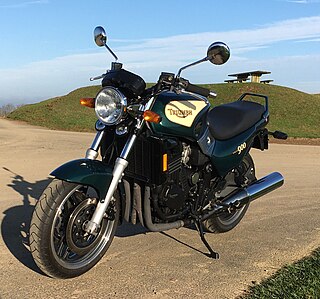
The Triumph Trident is a three-cylinder motorcycle of either 750 cc or 900 cc capacity. These bikes were produced from 1991 to 1998 at Hinckley, Leicestershire, England, by Triumph Motorcycles Ltd, the successor business to the defunct Triumph Engineering at Meriden Works, Warwickshire, England.
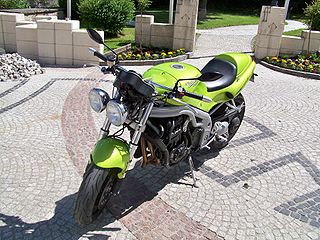
The Triumph Speed Triple is a series of motorcycles produced by Triumph Motorcycles. The 1994 Hinckley Triumph was one of the first motorcycles produced in the streetfighter style. The style originated with bikers who, having crashed their race replicas, put the bikes back on the road without fairing, and has since become popularised.

The Triumph Street Triple is a naked or streetfighter motorcycle made by Triumph Motorcycles, first released towards the end of 2007. The bike is closely modelled on the Speed Triple 1050 but uses a re-tuned inline three cylinder 675 cc engine from the Daytona 675 sport bike, which was released in 2006.
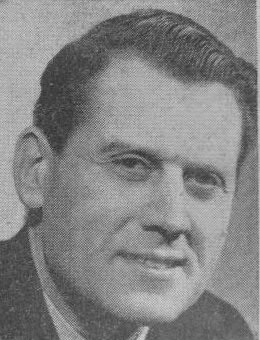
Douglas Lionel Hele was a pioneering British motorcycle engineer with Triumph and other firms: BSA, Douglas and Norton. He was born in Birmingham in 1919 and died in Hagley, Worcestershire on 2 November 2001.
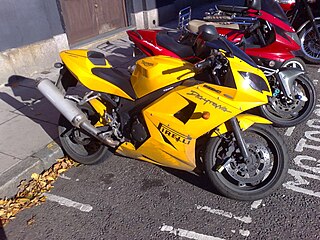
The Triumph Daytona 600 is a name given to two different motorcycles.
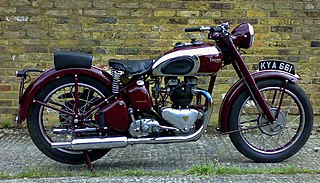
The Speed Twin 5T is a standard motorcycle that was made by Triumph at their Coventry, and later Meriden factories. Edward Turner, Triumph’s Chief Designer and Managing Director, launched the Triumph Speed Twin at the 1937 National Motorcycle Show. It was a 500 cc OHV vertical twin in a lightweight frame and the first truly successful British parallel twin, setting the standard for many twins to follow. After World War II the Speed Twin was responsible for the survival of Triumph, and several major British marques offered a 500 cc twin designed on similar lines to the Speed Twin.

The Tiger 100 (T100) was a standard motorcycle first made by the British motorcycle company Triumph in 1939. Production ceased when the Triumph factory was destroyed by German bombing in 1940 during World War 2, but recommenced in 1946. Several variants were manufactured until 1973.
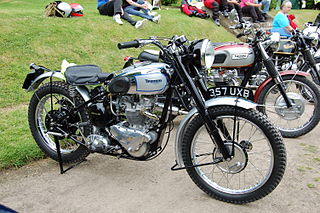
The TR5 Trophy was a standard motorcycle made by Triumph Engineering at the Meriden factory between 1949 and 1958.

The Triumph Thruxton is a series of British motorcycles with parallel-twin engines and sports styling. The name Thruxton was first applied to a handbuilt machine for endurance racing in the mid 1960s, and later revived in the 2000s.

Triumph Motorcycles Ltd is the largest UK-owned motorcycle manufacturer, established in 1983 by John Bloor after the original company Triumph Engineering went into receivership. The new company, initially called Bonneville Coventry Ltd, continued Triumph's lineage of motorcycle production since 1902. They have major manufacturing facilities in Thailand.
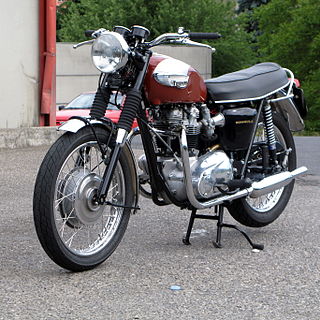
The Triumph Bonneville T120 is a motorcycle originally made by Triumph Engineering from 1959 to 1975. It was the first model of the Bonneville series, which was continued by Triumph Motorcycles Ltd. The T120 was discontinued in favour of the larger 750 cc T140 in the early 1970s.
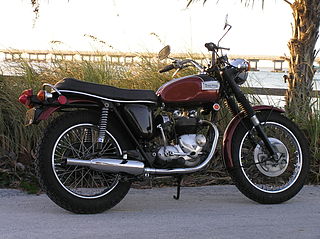
The Triumph Tiger Daytona is a motorcycle made by Triumph from 1967 to 1974.

The original Tiger 900, manufactured by Triumph Motorcycles Ltd was introduced in 1993 and remained in production with minor improvements until 1998. Known to its fans as the 'Steamer', a nickname identifying it as a Hinckley Tiger, not a Meriden Tiger, and also distinguishing it as a carburettor, not fuel injected engine, this 885 cc dual sport motorcycle sold in comparatively small numbers in its native UK, but with some relative success in the USA and continental Europe, particularly Germany.
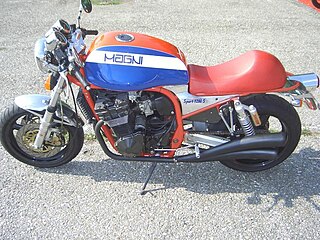
Magni is an Italian company that builds specialist motorcycles. The company is based in the city of Samarate in the province of Varese. Magni, in addition to building the bikes that bear its name, is also active in the construction of specials to order and a supplier of special parts for the restoration of MV Agusta classic motorcycles.

The Triumph Trophy is a three or four-cylinder touring motorcycle of either 885 cc or 1,180 cc capacity. These bikes were produced from 1991 to 2003 at Hinckley, Leicestershire, England, by Triumph Motorcycles Ltd, the successor business to the defunct Triumph Engineering at Meriden Works, Warwickshire, England.


















